- Unit6 Jan 2014
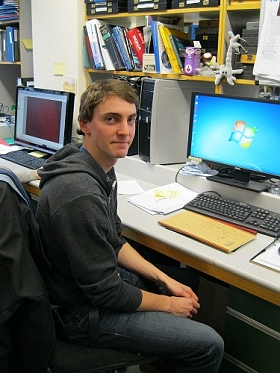
Mark is a current student on the MSc Neuroscience course, joining the Bolam group under the supervision of Dr Mena-Segovia for 3 months. His project aims to characterise the physiological effects of cholinergic transmission in the basal ganglia using juxtacellular recordings and neuroanatomical techniques. Mark received his BSc in Pharmacology from Newcastle University, where he studied the effects of early-life stress on gamma oscillations in the basolateral amygdala.
- Unit6 Jan 2014
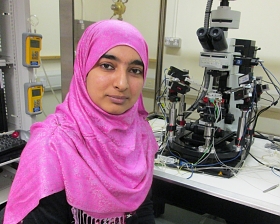
Miss Fahrat is visiting the laboratory from January until July 2014 to study GABAergic inhibitory interneurons in the hippocampus. For the visit, she was awarded a stipend from Higher Education Commission of Pakistan. Her visit is part of her Ph.D. in National University of Sciences and Technology in Islamabad, Pakistan.
- Unit18 Dec 2013
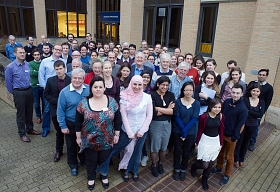
The Unit held its Winter Science Day on Wednesday 18th December 2013. 67 Unit members and visitors attended, including guest speakers Prof. John Jefferies and Prof. Matthew Walker. There were 12 oral presentations and 9 posters describing on-going projects and plans for the future. This Science Day was also a celebration of both the Unit's 25th year, and the Centenary of the MRC.
- Unit29 Oct 2013
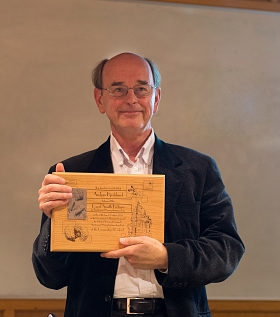 Prof Anders Björklund receives a plaque celebrating his lecture.
Prof Anders Björklund receives a plaque celebrating his lecture.Use of stem cells for dopamine cell replacement in Parkinson's disease.
Anders gave an inspiring lecture plotting the history of cell transplantation studies. He took us from the very beginnings of the field in the seventies and eighties describing his early studies in animal models, through the first clinical trials in Parkinson's disease and more recent data on the use of stem cell and strategies for the conversion of stem cell into dopamine neurons. We all look forward to the culmination of this work when trials of stem cell-derived dopamine neurons can be used in the treatment of Parkinson's disease.
The Lecture each year celebrates the vision of the previous Chair of Pharmacology and founding Director of the Unit, Prof. A. David Smith, currently Honorary Associate Director and Emeritus Professor, and the successful conclusion of the last quinquennial scientific review of the Unit.
To commemorate the lecture Prof. Björklund received a laser-engraved cherry-wood plaque, designed by Unit Artist, Ben Micklem, illustrating aspects of Anatomical Neuropharmacology at Oxford from molecules to the brain.
- Unit21 Oct 2013
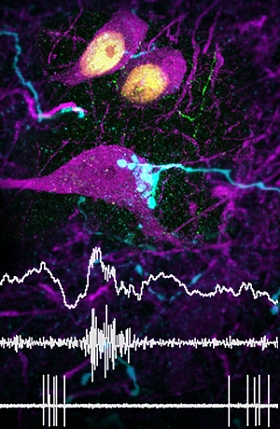 Selective GABAergic input to SATB1-immunonegative axo-axonic cells and inhibition during sharp waves in vivo. GABAergic interneurons immunoreactive for the calcium-binding protein parvalbumin (magenta) are found in the CA3 area of the hippocampus. Some express the transcription factor SATB1 (yellow; top two cells), whereas others lack detectable SATB1 immunoreactivity (bottom cell). Axo-axonic cells, which are SATB1 immunonegative interneurons, are selectively innervated by GABAergic neurons of the medial septum (cyan, anterogradely-labelled medial septal axons and boutons). In CA3 during sleep and awake immobility, sharp waves (top trace) are initiated and occur simultaneously with high-frequency 'ripples' (middle trace; 130-230 Hz). The firing of axo-axonic cells (bottom trace; action potentials from a single cell) is silenced during sharp waves.
Selective GABAergic input to SATB1-immunonegative axo-axonic cells and inhibition during sharp waves in vivo. GABAergic interneurons immunoreactive for the calcium-binding protein parvalbumin (magenta) are found in the CA3 area of the hippocampus. Some express the transcription factor SATB1 (yellow; top two cells), whereas others lack detectable SATB1 immunoreactivity (bottom cell). Axo-axonic cells, which are SATB1 immunonegative interneurons, are selectively innervated by GABAergic neurons of the medial septum (cyan, anterogradely-labelled medial septal axons and boutons). In CA3 during sleep and awake immobility, sharp waves (top trace) are initiated and occur simultaneously with high-frequency 'ripples' (middle trace; 130-230 Hz). The firing of axo-axonic cells (bottom trace; action potentials from a single cell) is silenced during sharp waves.Tim Viney and his colleagues established that GABAergic axo-axonic interneurons, which only innervate the axon initial segments of pyramidal cells, are inhibited in the CA3 area of the hippocampus during so-called sharp wave-ripple events (SWRs). These SWRs represent population bursts of pyramidal cells and are initiated in the CA3 area. Axo-axonic cells, which activate GABA-A receptors, were previously discovered by members of the MRC Unit. Pyramidal cells fire sequentially during active behaviour and these sequences are replayed in a time-compressed manner during slow wave sleep and awake consummatory behaviour; at times when hippocampo-neocortical readout and memory consolidation take place. The paper also reports a selective GABAergic input to axo-axonic cells from the medial septum, and that some GABAergic medial septal neurons are activated during SWRs. The authors hypothesize that the silencing of the axo-axonic cells during SWRs enables the pyramidal cells to discharge and replay the sequences of action potentials formed by connections when the animal was awake.
The discovery that axo-axonic cells are silenced during the replay of memory traces reveals the cellular mechanism of how withdrawal of inhibition at the strategic subcellular location, the axon initial segment of pyramidal cells, assists in memory consolidation. The results contribute to defining the chronocircuit of the brain, which is the mission of the Unit.
Viney, T.J.*, Lasztóczi, B.*, Katona, L.*, Crump, M.G.*, Tukker, J.J., Klausberger, T. & Somogyi, P. (2013) Network state-dependent inhibition of identified hippocampal CA3 axo-axonic cells in vivo. Nat. Neurosci. doi:10.1038/nn.3550.
*equal first authors.
- Unit21 Oct 2013
d3a9.jpg?itok=xKGukM-v)
Ms Maysa Falah has joined the Lamsa laboratory as a research student. Maysa graduated from the University of Science and Technology in Jordan and received her MSc degree in the Department of Pharmacology, University of Oxford under supervision of Professor Trevor Sharp. During her Master’s Maysa studied mechanisms of depression in Parkinson ’s disease. In her thesis, Maysa investigates excitatoxic role of NMDAR hyperfunction in human hippocampal sclerosis. Her thesis project (started in 2013) is a collaboration between The Nuffield Department of Clinical Neurosciences and the Department of Pharmacology, University of Oxford, and is co-supervised by Dr. Arjune Sen and Dr. Karri Lamsa.
- Unit14 Oct 2013
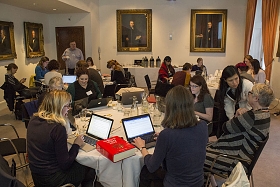 Royal Society Women in Science edit-a-thon, 11 October 2013 in London; Katie Chan/Wikimedia Commons.
Royal Society Women in Science edit-a-thon, 11 October 2013 in London; Katie Chan/Wikimedia Commons.On Friday 11th October postdoctoral researcher Dr Megan Dowie participated in a Wikimedia UK Women in Science Edit-a-thon. Hosted at the Royal Society in London and as part of the Medical Research Council Centenary celebrations, the workshop was held to improve Wikipedia articles about women in science.
Coinciding with Ada Lovelace Day, representatives from Wikimedia UK explained how Wikipedia works and supported participants to develop new pages and edit current pages. There was a particular emphasis on women scientists, as they are often poorly represented online and many female Royal Society Fellows were not previously included on Wikipedia.
In acknowledging that Wikipedia is a first source of information for lots of Internet searches, many organisations (such as the Science Museum in London) are embracing this by employing a ‘Wikimedian in Residence’. As an alternative to this model, the edit-a-thon’s aim to train up new editors, especially more scientists. The Royal Society and Wellcome Trust made their library resources open access for the day, as essential sources of biographical information. Anyone can edit Wikipedia, following the guidance of the Five Pillars, including such simple principles as maintaining a neutral point of view. Megan found the day really rewarding and would encourage others to learn how to edit Wikipedia.
This year Ada Lovelace Day is on Tuesday 15th October, and is an international celebration of women in science. Lovelace worked with Charles Babbage, who is credited with inventing the first mechanical computer, while Lovelace herself is often described as the first computer programmer. There are many Ada Lovelace Day events happening; the objective of which is really about helping people “learn about the achievements of women in science, inspiring others and creating new role models”.
Information about future edit-a-thon events is available on the MRC Centenary website.
- Unit8 Oct 2013
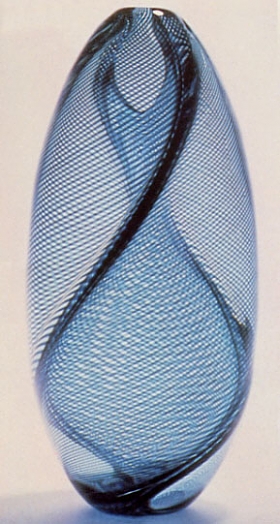 The mirror-image asymmetry for NMDA receptors expressed by CA1 hippocampal neurons and described in the paper by Ito and coll. can be detected in the main motive of the work of art shown.
The mirror-image asymmetry for NMDA receptors expressed by CA1 hippocampal neurons and described in the paper by Ito and coll. can be detected in the main motive of the work of art shown.A perspective paper has been published by Marco Capogna in the last issue of the Journal of Physiology (591.19). This article comments a paper published by Lujan, Shigemoto (ex Unit members), Ito and collaborators published in the same issue of the Journal of Physiology (http://jp.physoc.org./content/591/19/4777.long). The paper by Ito & coll. is the first to dissect out the cellular process that generates molecular asymmetries in the brain. Specifically, it identifies the major histocompatibility complex class I as key molecules involved in regulation of the asymmetry of NMDA receptors at hippocampal synapses.
- Unit1 Oct 2013
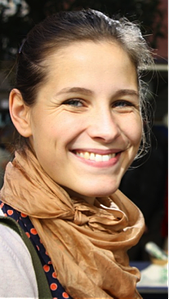
Anna received her B.Sc. in Biology from the Ludwig-Maximilians-University in Munich, where she studied the effects of galvanic stimulation on the vestibular system of Xenopus laevis tadpoles. Anna recently completed her MSc in Neuroscience at Oxford having worked on sensorimotor integration of speech and the thalamocortical engagement of interneurons in the developing mouse somatosensory cortex.
Anna joined the MRC Unit in 2013 to study for her D.Phil. under the supervision of Paul Dodson and Paul Bolam and will combine behavioural assessment with in vivo electrophysiological recording to investigate a new transgenic rat model of Parkinson’s disease.
- Unit1 Oct 2013
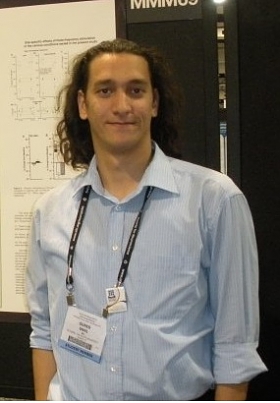
Dr Gunes Unal was awarded the Blaschko Fellowship of the Department of Pharmacology and has joined Professor Somogyi’s laboratory as a postdoctoral scientist for two years. He will join the work on analysing neuronal circuits contributing to the cell type specific firing patterns during rhythmic cortical activity.
Dr Unal completed his early studies in Turkey graduating with BA from Boğaziçi University in Psychology. He then went on to Rutgers University, Newark to complete his DPhil in Behavioural & Neural Sciences under the supervision of Dr Denis Paré and spent a further period in the Paré laboratory as a postdoctoral researcher.
Gunes Unal, John Apergis-Schoute, U Denis Paré Associative Properties of the Perirhinal Network Cereb. Cortex (2012) 22 (6): 1318-1332.
Unal G, Paré J-F, Smith Y, Paré D (2013) Differential connectivity of short- vs. long-range extrinsic and intrinsic cortical inputs to perirhinal neurons. J Comp Neurol. 521:2538-2550.